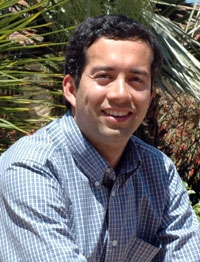
Assistant Professor Eric Johnsen has been selected by the National Science Foundation as a CAREER Awardee, based on his research proposal entitled “Shock Waves and Cavitation in Human Tissue.”
The Faculty Early Career Development (CAREER) Program, which exists within the National Science Foundation, offers awards to junior faculty who have exemplified the ideal teacher-scholar dynamic. In other words, the program advocates research in unison with education as a means to further a specific mission. The grant differs from other NSF awards, in that the stakes are set higher. Projects are expected to be new and innovative, and there is greater focus placed on education as well as outreach.
Johnsen directs the Computational Flow Physics Laboratory here at the University, where his CAREER sponsored research project unfolds. His research group is quite diverse, and includes students with all levels of experience, from undergraduates to PhD students.
“We have the luxury of working with some of the brightest students in the US, in the world, and my students are no exception,” Johnsen said.
The broader focus of the lab is constituted by fluid mechanics, including multiphase flows. Johnsen explores and explains such topics in greater depth in his research proposal.
Shock waves and cavitation occur as a result of therapeutic ultrasound and blast-induced traumatic brain injury and can cause tissue damage. Researchers have developed a thorough understanding of how bubbles and shock waves behave in water, but the same cannot be said for how they affect soft tissue in the body. The less known nature of these phenomena in soft tissue hinders the timely and accurate assessment of tissue damage, and Johnsen’s research team is trying to change this.
The other half of the project is an outreach program, developed by Johnsen and his lab. Johnsen and his research team are working side by side with the Natural History Museum on campus, as part of the Science for Tomorrow program. In order to spark children’s interest in science and its many applications, the research team has set up a booth that is visited by about 100 of the program’s middle school students. Johnsen uses an ultra sound device to give children a visual of internal functions and organs, from blood flow to the liver.
Initially, when Johnsen arrived at the University, he was primarily interested in the environmental applications of mechanical engineering, but soon discovered the path he follows today.
“I soon appreciated the fundamental nature and mathematical rigor of fluid mechanics, as a discipline underlying many engineering applications,” Johnsen said.
His last undergraduate design project focused on multiphase flow, in the form of vapor and liquids. This led him to pursue yet another multiphase flow research project for his PhD. This time, he began to explore medical field applications as he studied the effect of cavitation bubbles on kidney stone treatment.
“This project showed me how fundamental studies in an ‘old’ discipline like fluid mechanics using new methods (high-fidelity numerical simulations) can, in fact, impact society by improving medical procedures,” Johnsen explained.
Johnsen said that bubbles are fascinating in many fields. Throughout his career, he has revealed the unknown complexity of the nature of cavitations, of bubbles and their affect on medical treatment, as well as on the body.
Johnsen’s mission stands to understand and predict the response of soft tissue to shocks and cavitation with realistic material and pulse properties. This is not the first time that his research has been honorably recognized, as he was awarded the Young Investigator’s Award in 2012 from the Office of Naval Research. He received the award based on his exploration of how bubbles erode propellers and other naval engineering devices.
For more information, visit the NSF Award Abstract page
